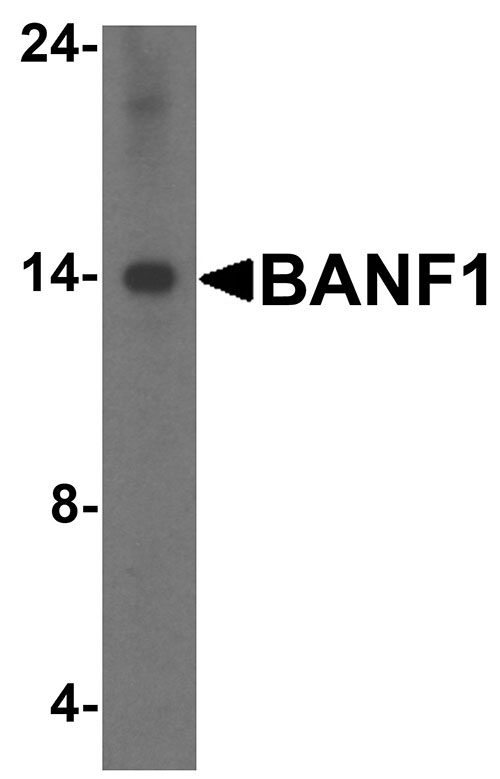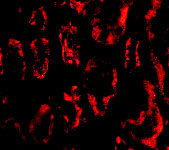BANF1 Antibody
- 产品详情
- 实验流程
- 背景知识
Application
| WB, IF, E |
|---|---|
| Primary Accession | O75531 |
| Other Accession | AAH05942, 13543577 |
| Reactivity | Human, Mouse, Rat |
| Host | Rabbit |
| Clonality | Polyclonal |
| Isotype | IgG |
| Calculated MW | 10059 Da |
| Concentration (mg/ml) | 1 mg/mL |
| Conjugate | Unconjugated |
| Application Notes | BANF1 antibody can be used for detection of BANF1 by Western blot at 0.5 - 2 µg/mL. Despite its predicted molecular weight, BANF1 often migrates at a higher size in SDS-PAGE. Antibody can also be used for immunoflourescence starting at 20 µg/mL. |
| Gene ID | 8815 |
|---|---|
| Other Names | BANF1 Antibody: BAF, NGPS, BCRP1, D14S1460, BAF, BCRG1, Barrier-to-autointegration factor, Breakpoint cluster region protein 1, barrier to autointegration factor 1 |
| Target/Specificity | BANF1; |
| Reconstitution & Storage | BANF1 antibody can be stored at 4℃ for three months and -20℃, stable for up to one year. As with all antibodies care should be taken to avoid repeated freeze thaw cycles. Antibodies should not be exposed to prolonged high temperatures. |
| Precautions | BANF1 Antibody is for research use only and not for use in diagnostic or therapeutic procedures. |
| Name | BANF1 {ECO:0000303|PubMed:21549337, ECO:0000312|HGNC:HGNC:17397} |
|---|---|
| Function | Non-specific DNA-binding protein that plays key roles in mitotic nuclear reassembly, chromatin organization, DNA damage response, gene expression and intrinsic immunity against foreign DNA (PubMed:10908652, PubMed:11792822, PubMed:12163470, PubMed:18005698, PubMed:25991860, PubMed:28841419, PubMed:31796734, PubMed:32792394). Contains two non-specific double-stranded DNA (dsDNA)-binding sites which promote DNA cross-bridging (PubMed:9465049). Plays a key role in nuclear membrane reformation at the end of mitosis by driving formation of a single nucleus in a spindle-independent manner (PubMed:28841419). Transiently cross-bridges anaphase chromosomes via its ability to bridge distant DNA sites, leading to the formation of a dense chromatin network at the chromosome ensemble surface that limits membranes to the surface (PubMed:28841419). Also acts as a negative regulator of innate immune activation by restricting CGAS activity toward self-DNA upon acute loss of nuclear membrane integrity (PubMed:32792394). Outcompetes CGAS for DNA-binding, thereby preventing CGAS activation and subsequent damaging autoinflammatory responses (PubMed:32792394). Also involved in DNA damage response: interacts with PARP1 in response to oxidative stress, thereby inhibiting the ADP-ribosyltransferase activity of PARP1 (PubMed:31796734). Involved in the recognition of exogenous dsDNA in the cytosol: associates with exogenous dsDNA immediately after its appearance in the cytosol at endosome breakdown and is required to avoid autophagy (PubMed:25991860). In case of poxvirus infection, has an antiviral activity by blocking viral DNA replication (PubMed:18005698). |
| Cellular Location | Nucleus. Chromosome. Nucleus envelope. Cytoplasm. Note=Significantly enriched at the nuclear inner membrane, diffusely throughout the nucleus during interphase and concentrated at the chromosomes during the M-phase (PubMed:16495336, PubMed:24600006). The phosphorylated form (by VRK1) shows a cytoplasmic localization whereas the unphosphorylated form locates almost exclusively in the nucleus (PubMed:16495336, PubMed:24600006). May be included in HIV-1 virions via its interaction with viral GAG polyprotein (PubMed:14645565) |
| Tissue Location | Widely expressed. Expressed in colon, brain, heart, kidney, liver, lung, ovary, pancreas, placenta, prostate, skeletal muscle, small intestine, spleen and testis. Not detected in thymus and peripheral blood leukocytes. |
For Research Use Only. Not For Use In Diagnostic Procedures.
Provided below are standard protocols that you may find useful for product applications.
BACKGROUND
BANF1 Antibody: Barrier-to-autointegration factor 1 (BANF1) is a conserved chromatin protein that non-specifically binds double-stranded DNA. BAF also interacts with a family of nuclear proteins that include LAP2, emerin, and MAN1. It is also a host cell component of retroviral pre-integration complexes (PICs), including that of HIV. BAF will bind to p55 Gag (the structural precursor of HIV-1 virions) as well as its cleaved product matrix. In addition to being a host cell component of the PIC, it is thought that BAF is also present at low levels in incoming virions, and thus might contribute to the assembly or activity of HIV-1 PICs through direct binding to matrix as well as DNA.
REFERENCES
Furukawa K. LAP2 binding protein 1 (L2BP1/BAF) is a candidate mediator of LAP2-chromatin interaction. J. Cell Sci. 1999; 112:2485-92.
Cai M, Huang Y, Ghirlando R, et al. Solution structure of the constant region of nuclear envelope protein LAP2 reveals two LEM-domain structures: one binds BAF and the other binds DNA. EMBO J. 2001; 20:4399-407.
Chen H and Engelman A. The barrier-to-autointegration protein is a host factor for HIV type 1 integration. Proc. Natl. Acad. Sci. USA 1998; 95:15270-4.
终于等到您。ABCEPTA(百远生物)抗体产品。
点击下方“我要评价 ”按钮提交您的反馈信息,您的反馈和评价是我们最宝贵的财富之一,
我们将在1-3个工作日内处理您的反馈信息。
如有疑问,联系:0512-88856768 tech-china@abcepta.com.























 癌症的基本特征包括细胞增殖、血管生成、迁移、凋亡逃避机制和细胞永生等。找到癌症发生过程中这些通路的关键标记物和对应的抗体用于检测至关重要。
癌症的基本特征包括细胞增殖、血管生成、迁移、凋亡逃避机制和细胞永生等。找到癌症发生过程中这些通路的关键标记物和对应的抗体用于检测至关重要。 为您推荐一个泛素化位点预测神器——泛素化分析工具,可以为您的蛋白的泛素化位点作出预测和评分。
为您推荐一个泛素化位点预测神器——泛素化分析工具,可以为您的蛋白的泛素化位点作出预测和评分。 细胞自噬受体图形绘图工具为你的蛋白的细胞受体结合位点作出预测和评分,识别结合到自噬通路中的蛋白是非常重要的,便于让我们理解自噬在正常生理、病理过程中的作用,如发育、细胞分化、神经退化性疾病、压力条件下、感染和癌症。
细胞自噬受体图形绘图工具为你的蛋白的细胞受体结合位点作出预测和评分,识别结合到自噬通路中的蛋白是非常重要的,便于让我们理解自噬在正常生理、病理过程中的作用,如发育、细胞分化、神经退化性疾病、压力条件下、感染和癌症。







